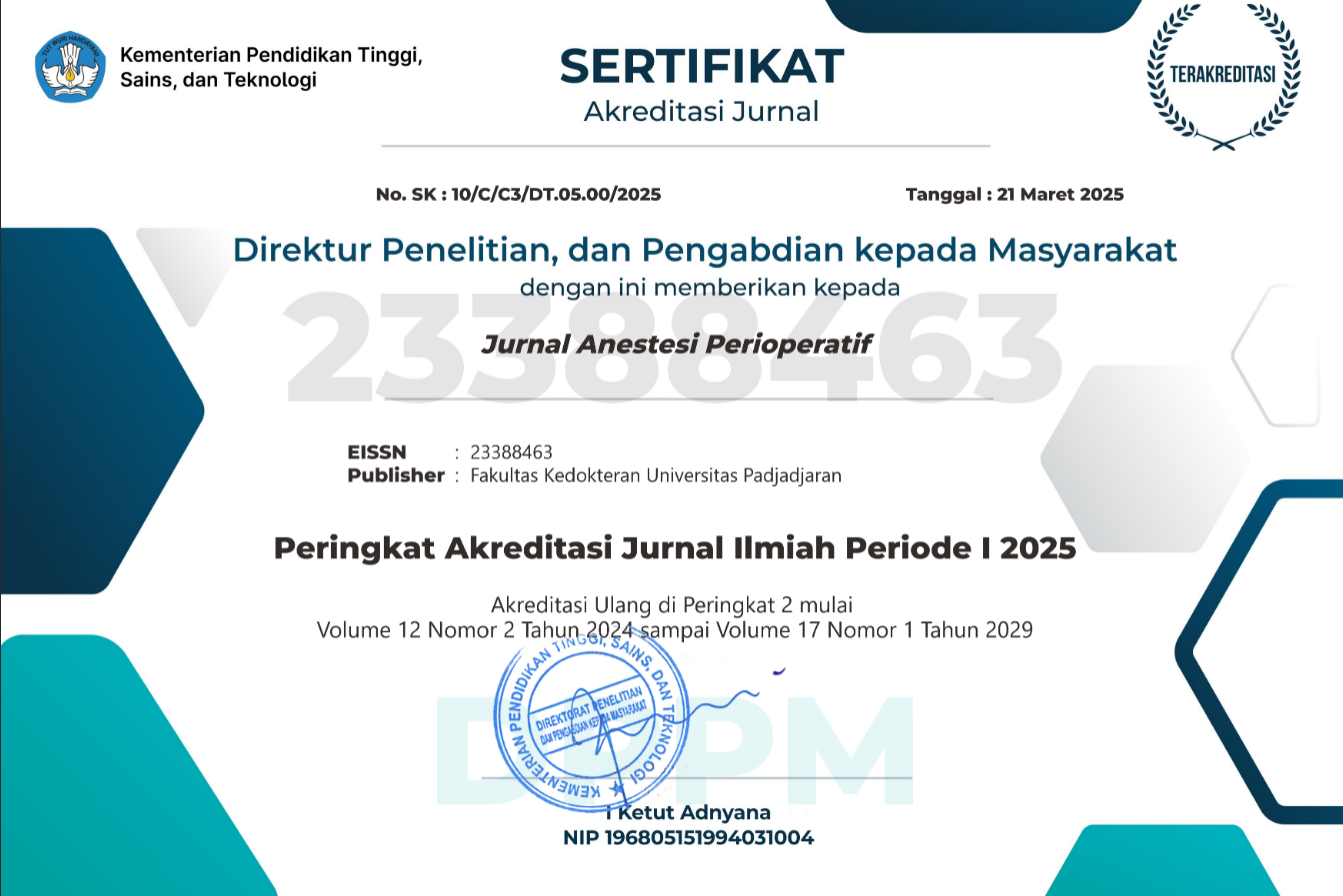Pengaruh Premedikasi Ketamin 0,3 Mg/kgBB terhadap Respons Tubuh Pasien Saat Insersi Jarum Spinal dan Penerimaan Pasien
Abstract
Pemberian premedikasi dapat mengurangi kecemasan preoperatif dan respons tubuh pasien saat insersi jarum spinal. Premedikasi membuat intervensi spinal menjadi lebih nyaman bagi pasien, pasien kooperatif selama penyuntikan, dan mengurangi respons saat insersi jarum spinal. Tujuan penelitian ini mengetahui pengaruh premedikasi ketamin 0,3 mg/kgBB yang diberikan 3 menit sebelum dilakukan anestesi spinal terhadap respons tubuh pasien saat insersi jarum spinal dan penerimaan pasien terhadap anestesi spinal. Penelitian dilakukan periode Agustus–Desember 2020 di RSUP Dr. Hasan Sadikin Bandung. Penelitian bersifat komparatif eksperimental dengan menggunakan uji klinis acak buta ganda terhadap 46 subjek yang dibagi acak ke dalam 2 kelompok, yaitu kelompok kontrol (kelompok C, n=23) dan kelompok premedikasi ketamin (kelompok K, n=23). Pascapemberian premedikasi ketamin dinilai respons tubuh pasien saat insersi jarum spinal menggunakan prick response score dan penerimaan pasien dengan numeric rating scale. Analisis statistik untuk respons penyuntikan dan penerimaan pasien diuji dengan tes chi-square. Hasil penelitian menunjukkan respons tubuh pasien saat insersi jarum spinal berkurang (p<0,01) dan penerimaan pasien meningkat (p<0,01) pada kelompok perlakuan. Simpulan penelitian, yaitu premedikasi ketamin 0,3 mg/kgBB yang diberikan 3 menit sebelum anestesi spinal menurunkan respons tubuh pasien saat insersi jarum spinal dan meningkatkan penerimaan pasien terhadap anestesi spinal.
The Effect of Ketamine Premedication 0.3 mg/kgBW before Spinal Anesthesia to Body Response during Spinal Needle Insertion and Satisfaction
Premedication may reduce preoperative anxiety and response during spinal needle insertion. Premedication leads to a more comfortable spinal intervention for the patients, making them more cooperative and allaying response during spinal needle insertion. The aims of this study were to determine the effects of 0.3 mg/kgBW ketamine premedication administered 3 minutes before spinal anesthesia on the patient`s body response during spinal needle insertion and patient satisfaction. The study was conducted in August–December 2020 in Dr. Hasan Sadikin General Hospital Bandung. This was a comparative experimental study with a randomized, double blinded clinical trial on 46 subjects randomly divided into 2 groups, a control group (group C, n=23), and a ketamine premedication group (group K, n=23). After premedication with ketamine, the patient`s body response were evaluated during spinal needle insertion using the prick response score and their satisfaction using the numeric rating scale. Statistical analysis for response during needle insertion and patient satisfaction was evaluated using the chi-square test. Results of the study showed that patient`s body response during spinal needle insertion were reduced (p<0.01) and patient satisfaction was increased (p<0.01) in the ketamine premedication group. In conclusion, 0.3 mg/kgBW ketamine premedication administered 3 minutes before spinal anesthesia reduces patient body response during spinal needle insertion and increases patient satisfaction on spinal anesthesia.
Keywords
Full Text:
PDFReferences
Torpy JM, Lynm C, Golub RM. Regional anesthesia. J Am Med Assoc. 2011;306(7):781.
Kettner SC, Willschke H, Marhofer P. Does regional anaesthesia really improve outcome?. Br J Anaesth. 2011;107:90–5.
Mingir T, Ervatan Z, Turgut N. Spinal anesthesia and perioperative anxiety. Turk J Anaesth Reanim. 2014;42:190–5.
Savant KB, Patel H, Patel V. Sedation during spinal anaesthesia: a comparison between Dexmedetomidine and midazolam infusion. IJBAR. 2017;8(05):228–32.
Senel AC, Mergan F. Premedication with midazolam prior to caesarean section has no neonatal effects. Rev Bras Anestesiol. 2014;64(1):16–21.
Sheen MJ, Chang FL, Ho ST. Anesthetic premedication: new horizons of an old practice. Acta Anaesthesiol Taiwan. 2014;52:134–42.
Nidal M, Moath K, Mohamed S, Bassam A, Mohmoud H. Ketamine administration prior regional anesthesia for fractured femur. Sch J App Med Sci. 2018;6(5):2139–44.
Kumar VRH, Athiraman UK, Jahagirdar SM, Sripriya R, Parthasarathy S, Ravishankar M. Comparison of efficacy of three subanesthetic doses of ketamin in allaying procedural discomfort during establishment of subarachnoid block: a randomized double-blind trial. Saudi J Anaesth. 2015;9(1):55–9.
Lee JS. Spinal anesthesia: how can we improve patient satisfaction?. Korean J Anesthesiol. 2010;59(4):231–2.
Rishi B, Berri H, Kalpakjian C, Smuck M. The effect of local anesthesia administration on pain experience during interventional spine procedures: a prospective controlled trial. Pain Med. 2016;17:488–93.
Strazar AR, Leynes PG, Lalonde DH. Minimizing the pain of local anesthesia injection. Plast Reconstr Surg. 2013;132:675–84.
Dilli D, Dallar Y, Sorgui NH. Intravenous ketamin plus midazolam vs. intravenous ketamin for sedation in lumbar puncture: a randomized controlled trial. Indian Pediatr. 2012;45:899–904
Gazal G, Fareed WM, Zafar MS, Al-Samadani KH. Pain and anxiety management for pediatric dental procedures using various combination of sedative drugs: a review. Saudi Pharm J. 2016;24:379–8.
Mui WC, Chang CM, Cheng KF, Lee TY, Ng KO, Tsao KR, dkk. Development and validation of the questionnaire of satisfaction with perioperative anesthetic care for general and regional anesthesia in taiwanese patients. Anesthesiology. 2011;114(5):1064–75.
Kurdi MS, Theerth KA, Deva RS. Ketamine: current applications in anesthesia, pain, and critical care. Anesth Essays Res. 2014;8(3):283–90.
Gorlin AW, Rosenfeld DM, Ramakrishna H. Intravenous sub-anesthetic ketamin for perioperative analgesia. J Anaesthesiol Clin Pharmacol. 2016;32:160–7.
Gebremedhin HG, Mihrete DB, Binwe KM. Maternal satisfaction after spinal anesthesia for cesarean delivery in gandhi memorial hospital, ethiopia. EJPMR. 2017;4(3):145–50.
Guerrero FJB, Camargo DG, Romero RP, Bustos WL, Clason ER. A comparative analysis of 3 sedation guidelines for patients undergoing subarachnoid anesthesia. Randomized, single blind clinical trial. Rev Colomb Anestesiol. 2015;43(2):122–8.
DOI: https://doi.org/10.15851/jap.v9n2.2419
Article Metrics
Abstract view : 1516 timesPDF - 585 times
This Journal indexed by

JAP is licensed under a Creative Commons Attribution-NonCommercial 4.0 International License
View My Stats



